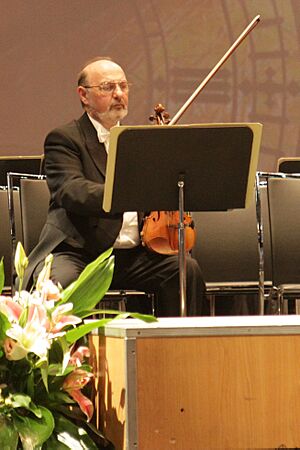Concertmaster facts for kids

The Concertmaster (from the German Konzertmeister) is a very important musician in an orchestra, symphonic band, or other music group. They are usually the second most important person after the conductor. In the U.S., they are often called the "First Chair." In the U.K., they are known as the "leader."
Contents
What a Concertmaster Does in an Orchestra
In an orchestra, the concertmaster is the main leader of the first violin section. There's also a second violin section, led by a different principal player. If an orchestral piece has a violin solo, the concertmaster usually plays it. The only exception is if a special guest soloist is playing a concerto.
The concertmaster needs to be a very skilled musician. They must learn music quickly and count rests (silent parts) perfectly. They also guide the rest of the string section with their playing and how they move their bow.
Where the Concertmaster Sits
The concertmaster sits to the conductor's left. This spot is closest to the audience. It's often called the "first chair" or "first desk." For example, Ferdinand David was the concertmaster of the Leipzig Gewandhaus Orchestra for many years.
Making Decisions for Strings
The concertmaster makes important decisions about how the violins should use their bows. They also decide other technical details for the violin section. Sometimes, they even make these decisions for all the string players.
Leading the Tuning
Before concerts and rehearsals, the concertmaster leads the orchestra in tuning. This is more than just a quick check. If the concertmaster thinks a section isn't tuned well, they will signal the oboe player to play another "A" note. This helps everyone get perfectly in tune.
Assistant Concertmasters
Some larger orchestras have one or more assistant concertmasters. These assistants lead the orchestra when the main concertmaster is not there.
Helping with Auditions
The concertmaster often helps choose new musicians for the orchestra. They join the conductor and other section leaders in auditions for important players.
What a Concertmaster Does in a Concert Band
In a standard concert band, the concertmaster is usually the main clarinet, oboe, flute, or saxophone player. They lead the band's tuning. The first-chair clarinet concertmaster will play all the solos for their instrument. Sometimes, the main flutist has similar duties. This depends on things like their age, skill, and how long they've been in the group.
The concertmaster in both orchestras and wind bands works with other section leaders. They are often seen as the most senior (most experienced) player in the group.
What a Concertmaster Does in a Brass Band
In brass bands, the concertmaster role is often taken by the main solo cornet or trumpet player.
Important Duties of a Concertmaster
The concertmaster has many important jobs. They act as a link between the conductor and the orchestra. They are responsible to both the conductor and the musicians.
Guiding Bowing for Violins
One key job is to decide the "bowings" for the first violins before rehearsals. This means they know a lot about different ways to play string instruments. They also understand how string playing works. Other string section leaders will then base their bowings on what the concertmaster decides. They might talk during rehearsal to make sure everyone plays together.
Explaining Conductor's Instructions
Another main duty is to explain the conductor's instructions to the string players. Some conductors prefer to give general directions. They trust the concertmaster to translate these into specific playing techniques for the strings. This is because the concertmaster is an expert in string playing.
Providing Stable Leadership
Full-time orchestras often work with different conductors each week or month. The concertmaster stays the same. This gives the orchestra a sense of steady leadership every day. While the conductor's movements tell the orchestra when to play, musicians often watch the concertmaster's bow. This helps them play together more precisely.
Keeping Order in Rehearsals
The concertmaster also helps keep rehearsals orderly. They set a good example themselves. They also make sure all orchestra members are cooperating. It's often better for the concertmaster to ask for quiet if people are chatting. This is especially true if a guest conductor is not familiar with the orchestra.
Stage Presence
In America and with American or British orchestras, the concertmaster usually walks onto the stage alone. They do this after the rest of the orchestra is seated. They bow and receive applause for the orchestra before the conductor appears. In Europe, this is less common. There, the concertmaster usually walks on stage with the rest of the orchestra.
As the orchestra's representative, the concertmaster often shakes hands with the conductor. This happens at the start or end of a concert. It shows mutual respect and appreciation.
Some Famous Orchestral Leaders
From the past:
From today:
- Gordan Nikolitch (London Symphony Orchestra)
- Glenn Dicterow (New York Philharmonic Orchestra)
Images for kids
See also
 In Spanish: Concertino para niños
In Spanish: Concertino para niños


